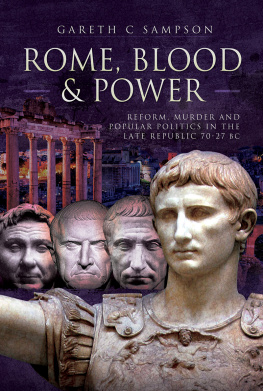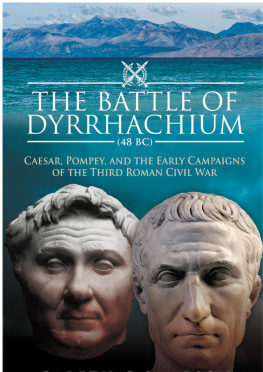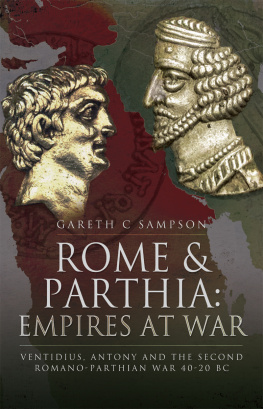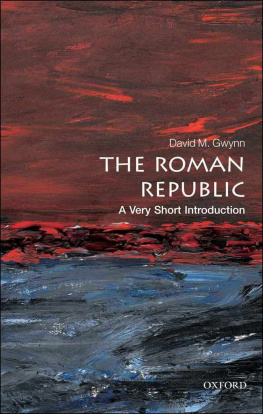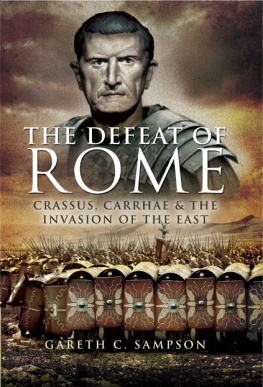Rome, Blood and Power

Rome, Blood and Power
Dedication
In memory of Geoff Sampson (19472019)
Rome, Blood and Power
Reform, Murder and Popular Politics in the Late Republic 7027 BC
Gareth C Sampson
First published in Great Britain in 2019 by
Pen & Sword Military
An imprint of
Pen & Sword Books Ltd
Yorkshire Philadelphia
Copyright Gareth C Sampson 2019
ISBN 978 1 52671 017 8
eISBN 978 1 52671 019 2
Mobi ISBN 978 1 52671 018 5
The right of Gareth C Sampson to be identified as Author of this work has been asserted by him in accordance with the Copyright, Designs and Patents Act 1988.
A CIP catalogue record for this book is available from the British Library.
All rights reserved. No part of this book may be reproduced or transmitted in any form or by any means, electronic or mechanical including photocopying, recording or by any information storage and retrieval system, without permission from the Publisher in writing.
Pen & Sword Books Limited incorporates the imprints of Atlas, Archaeology, Aviation, Discovery, Family History, Fiction, History, Maritime, Military, Military Classics, Politics, Select, Transport, True Crime, Air World, Frontline Publishing, Leo Cooper, Remember When, Seaforth Publishing, The Praetorian Press, Wharncliffe Local History, Wharncliffe Transport, Wharncliffe True Crime and White Owl.
For a complete list of Pen & Sword titles please contact
PEN & SWORD BOOKS LIMITED
47 Church Street, Barnsley, South Yorkshire, S70 2AS, England
E-mail:
Website: www.pen-and-sword.co.uk
Or
PEN AND SWORD BOOKS
1950 Lawrence Rd, Havertown, PA 19083, USA
E-mail:
Website: www.penandswordbooks.com
Acknowledgements
T he first and greatest acknowledgement must go out to my wonderful wife Alex, without whose support none of this would be possible.
Special thanks go out to my parents who always encouraged a love of books and learning.
There are a number of individuals who through the years have inspired the love of Roman history in me and mentored me along the way: Michael Gracey at William Hulme, David Shotter at Lancaster and Tim Cornell at Manchester. My heartfelt thanks go out to them all.
A shout goes out to the remaining members of the Manchester diaspora: Gary, Ian, Jason, Sam. Those were good days.
As always, my thanks go out to my editor Phil Sidnell, for his patience and understanding.
List of Plates
Roman Forum
Possible bust of C. Marius
L. Cornelius Sulla
Cn. Pompeius Magnus
Possible bust of M. Licinius Crassus
M. Tullius Cicero
C. Iulius Caesar
M. Antonius
Augustus
M. Vipsanius Agrippa
Tiberius
List of Maps
Map 1: The Mediterranean World in 70 BC
Map 2: The Mediterranean World in 48 BC
Map 3. The Mediterranean World in 43 BC The Triumvirate
Map 4. The Mediterranean World in 42 BC Post Philippi
Map 5. The Mediterranean World in 40 BC
Map 6: The Mediterranean World in the 30s BC
Map 7: The Mediterranean World in 27 BC

Introduction: Out of the Ashes, the Struggle for Stability
T he year 70 BC saw the Roman Republic emerge from twenty years of civil war and bloody slaughter, which had brought the Roman Republic and its growing empire to the very brink of collapse. Out of the ashes of this conflict emerged a New Republic, or a re-founded one, as its architects (Pompeius and Crassus) would have preferred. Whilst this Republic maintained the offices and power structures identical to those from before the collapse, the key questions were whether this renewal would be permanent or merely an illusion; nothing more than a breathing space between bouts of civil war in a system that was locked into terminal decline. Was the Roman Republic and its ruling oligarchy capable of maintaining peace and stability whilst engaging in the age-old struggle for political advancement and the growth of empire?
The forty years which sit between the end of the First Civil War and the rise of Augustus are perhaps the most well known of all of Roman history, containing such dazzling figures as Pompeius and Caesar, Cato and Cicero, Catilina and Clodius, Antonius and Cleopatra. Yet aside from the larger-than-life personalities, immortalised in verse and now film, lies the functioning of the Roman Republican system and how it was able to recover from the devastating bloodshed of the Civil War and continue to function and rule an ever-growing Mediterranean and European empire.
The Roman Republican system had always had to manage the twin tensions of maintaining the public good (the res publica ) against the ambitions of its ruling oligarchy. Yet seemingly as Romes overseas empire expanded then the system was increasingly unable to keep these tensions under control and had seen escalating outbursts of political bloodletting (133, 121 and 100 BC ). This culminated in a full-scale war in Italy and then across the empire, between the various ethnic groups and individuals that made up the Republic, with Rome itself attacked on no less than four occasions in just over a decade. Yet when the bloodletting subsided it was up to a new generation of Roman politicians to restore the res publica , expand the empire and keep their ambitions under control.
As will be seen with the following volume, maintaining this balance proved to be equally, if not more difficult than before, and saw the Republican system continue its evolution and undergo a number of political experiments in an ever-increasing and desperate search for stability. This search for stability culminated in the 20s BC with the rise of one man with a vision for how he could re-introduce stability to the Republican system.
Central to this study is a unique political office, the Tribunate of the Plebeian Order, which evolved from humble origins as the mouthpiece of a disenfranchised section of the Roman populace to being the most powerful, and most dangerous, political office in the Roman Republican system, and ultimately the foundation for the role of Emperor.The origins of the current work lies in my doctoral thesis from the early twenty-first century: A re-examination of the office of the Tribunate of the Plebs in the Roman Republic (49423 BC ) , whose dry title concealed an analysis of what lay behind five centuries of political clashes and bloodshed; the very heart of the Roman Republican system.

